Strengthening the foundation of a private house is a time consuming but necessary procedure that most property owners have to follow. Almost all buildings that have stood for more than a dozen years require major repairs. As a rule, the foundation of the structure requires the most attention, since it is under constant pressure from the house itself and the ground. There are several ways to strengthen the foundation, manually and using heavy equipment. To achieve a high-quality and long-term result, you should familiarize yourself with the technologies used in this area and choose the best method.
- Possible causes of partial destruction of the foundation
- Inspection of the foundation to be strengthened
- Unloading the foundation
- Ways to strengthen the foundation
- Strengthening with shotcrete
- Reinforcement with a reinforced concrete jacket
- Reinforcement with bored piles
- Strengthening the foundation by widening the sole
Possible causes of partial destruction of the foundation
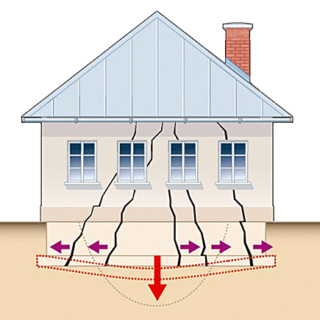
If, during the annual spring inspection of the building, after the snow melts, cracks are found on the plinth, you need to urgently strengthen the foundation of the house. If you delay this event, irreversible changes will begin in the structures of the entire building.
Violation of the integrity of the foundation can occur for the following reasons:
- long service life, material fatigue;
- making engineering mistakes at the design stage;
- violation of technology when arranging a pit, neglect of a sand and gravel bed and waterproofing;
- incorrect selection of components and proportions for the preparation of concrete solution;
- non-observance of the rules for servicing the foundation after pouring or the timing of its hardening;
- weakening of the soil due to the laying next to the building of communications, the installation of wells and septic tanks;
- high level of seismological activity in the region;
- heaving soil with a high coefficient of volume change;
- laying the foundation above the level of freezing of the earth;
- high groundwater level, which leads to erosion of the soil under the concrete.
Strengthening the strip foundation may be required for a recently erected structure if there has been a critical confluence of several destructive circumstances. In most cases, strengthening the foundation of a brick house allows you to save the situation and forget about such troubles for decades.
Inspection of the foundation to be strengthened
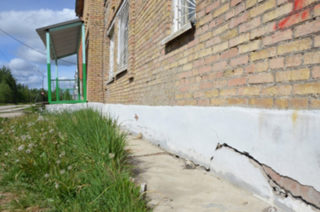
Before starting large-scale work, it is necessary to identify the factors that caused the process of destruction of the foundation. Eliminating them will allow you to avoid similar phenomena in the future. The first stage of the overhaul is external and internal inspection of the base, walls and blind area.
It is necessary to define the following parameters:
- the size and weight of the house as a factor in calculating the load;
- the condition of the walls, the presence or absence of signs of destruction;
- the presence and size of cracks;
- shape, type and size of the foundation;
- strength and external condition of concrete;
- laying depth;
- the presence of tree roots and voids under the base;
- tendency to deformation.
Before drawing up a step-by-step work plan, you should make sure that the base has finished shrinking. For this, plaster or putty beacons are installed on the cracks. If the process progresses, repairs should be started immediately.If you have doubts about the correctness of the diagnosis, it makes sense to invite specialists who will issue an accurate conclusion and recommendations on how to better and more reliably strengthen the foundation of the old house with your own hands.
Unloading the foundation
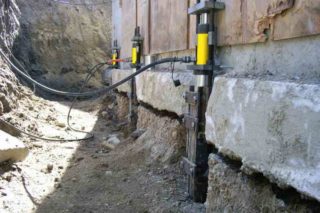
The final stage of preparation for the overhaul of the base is its unloading. This process is a series of actions aimed at reducing the pressure on the foundation and giving it its original shape. The removal of the load can be partial or complete, depending on the material of the walls and the degree of deformation of the base.
There are such ways to relieve pressure on the foundation:
- Using jacks. This technology is applicable for wooden houses made of timber, logs and bricks laid on a monolithic slab. Supports are installed along the perimeter of the house, and jacks are installed on them. Then, under the walls and slabs, beams are laid, the ends of which are laid on jacks. After lifting by 2-3 cm, the house is fixed on supports.
- With concrete. Pouring is carried out in problem areas where cracks are identified. Cobblestones are poured into the dug holes, and then the solution is poured. This will stabilize the base and stop the sinking process.
- Wedges. It is carried out from the inside and outside by installing a single structure of struts and supports. When it is fixed at the level of the basement, wedges are sequentially driven in until the building rises above the base.
After unloading, the foundation should be leveled, giving it an exact horizontal position. When the structure is stabilized, you can begin to strengthen it.
Ways to strengthen the foundation
Over the centuries of using concrete foundations for buildings, builders have developed many ways to repair and restore them, reaching almost absolute perfection in this direction.
Strengthening with shotcrete
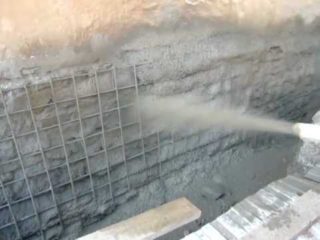
Shotcrete is the spraying of cement mortar onto the vertical walls of the emergency foundation. The purpose of the process is to expand the base and increase its bearing capacity, reduce the pressure on the ground, and eliminate the likelihood of subsequent subsidence. The technology is quite effective, but it has a small drawback - special equipment is required, which must be found, rented and delivered to the site. There is a dry and wet method for applying the mixture. In the first case, the components are mixed when they leave the nozzle, in the second, pre-prepared concrete is fed to the base.
The sequence of strengthening the foundation using the gunning method:
- Digging along the base of a trench with a width of at least 100 cm. Sealing the bottom of the ditch, laying waterproofing and sand cushion.
- Cleaning the walls from the ground, old finishes, treating their surface with a deep penetration primer.
- Reinforcement cage creation. It is needed for the strength and retention of the solution during the spraying process. The size of the lattice must correspond to the planned thickening. The optimal choice of material is a steel rod of 8 mm, from which a volumetric lattice with a mesh of 60-80 mm is welded.
- Concrete application. A mixture is made of water, sand and cement in a ratio of 3: 3: 1. To make the mixture plastic, plasticizers are added to it. Spraying is carried out in strips from the bottom up, covering 20 cm of previously treated areas. The recommended layer thickness is 5-7 mm.
The next day after spraying, the concrete should be sprinkled with water. This will improve the properties of the material and prevent cracking in it.
Reinforcement with a reinforced concrete jacket
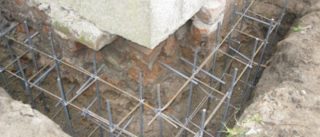
This technology is used to restore old and worn out foundations. In fact, it is the creation of a new, powerful base on the outside of the emergency structure.The process does not require the use of special equipment, if the owner has the opportunity to independently engage in earthworks. Otherwise, you will have to rent a mini excavator. It is expensive, but it will significantly speed up and facilitate repairs.
To strengthen the foundation for this technique, you must perform the following actions:
- Digging a ditch around the perimeter of the building 15-20 cm deep below the sole of the base. If necessary, pits are made at the corners, into which concrete is poured. It is advisable to make the trench the same width as the old base.
- Laying geotextile fabric and sand and gravel cushion at the bottom of the ditch. Cleaning the walls from dirt and trim residues. Applying a layer of primer.
- Steel frame fabrication and installation. It must be firmly and reliably connected to the old structure. For this, pins or anchor bolts embedded in it can be used.
- Preparation and pouring of concrete. The trench is filled, but if it is too wide, formwork is made. It is advisable to use a non-removable version in the form of foam plates, which will perform the functions of heat and waterproofing.
Reinforced strip foundation should be covered with a blind area. This structure protects the base from precipitation and melt water. As a result, it experiences less pressure when the soil heaves, and is protected from the effects of low temperatures during cold winters.
Reinforcement with bored piles
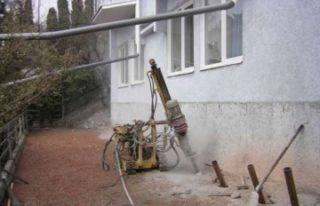
The bored method of strengthening foundations of any type is considered the most effective and modern. Its essence consists in laying piles under the base or through it to a depth that is determined by the properties of the soil and structural features. The borehole injection method is the production of wells with their subsequent filling with reinforcement, rubble stone and cement mortar. After its crystallization, a full-fledged reinforced concrete pile is obtained, which is an additional point of support. The probability of deformation, subsidence and destruction of the foundation is reduced to a minimum.
Supports are installed at an angle or vertically, close to the walls. The second method is more complicated and time consuming, since additional fastening of the supports to the foundation is required. The inclined method is no less reliable, but easier to implement. Piles can be installed outside and inside the base, if the size of the basement allows.
The repair is carried out in the following sequence:
- Marking. Drilling points are outlined at intervals of 150-200 cm.
- Manufacturing of frames. Preparation of components for the solution.
- Drilling of the wells. The best option is considered to be a diameter of 200-250 mm. The holes are made 100-200 cm deeper than the sole of the base, depending on the type of soil.
- Loading skeletons into wells. Aligning structures strictly in the center.
- Preparation and pouring of the solution. Compaction is carried out using a steel pin or a vibrator.
It takes at least 14 days to harden the concrete. Then the unloading is removed and external finishing works are carried out. If there is a high level of groundwater under the house, then steel or asbestos-cement pipes are inserted under it.
Strengthening the foundation by widening the sole
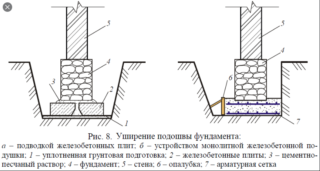
The widening of the sole is used when the old foundation is in critical condition. The essence of the technologist is the construction of a new foundation around the emergency structure.
Repair sequence:
- Digging a moat around the building. Cleaning the base from dirt.
- Installation of fixing props made of reinforced concrete blocks or piles under the foundation.
- Carrying out excavation from under the sole of the base.
- Laying reinforcement and pouring mortar. The walls expand by 20-30 cm and rise to the level of the base.
After the concrete has set, the soil is backfilled and compacted into the remaining voids.
When cracks appear in the foundation of a brick house, wedges and jacks cannot be used, since the slightest distortion will lead to cracks in the masonry, which is fraught with subsequent collapse of the walls. Products are installed on both sides in problem areas or around the entire perimeter of the foundation, after which they are fixed with ties. Then widening of the sole or installation of piles can be carried out.








